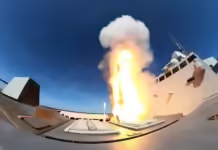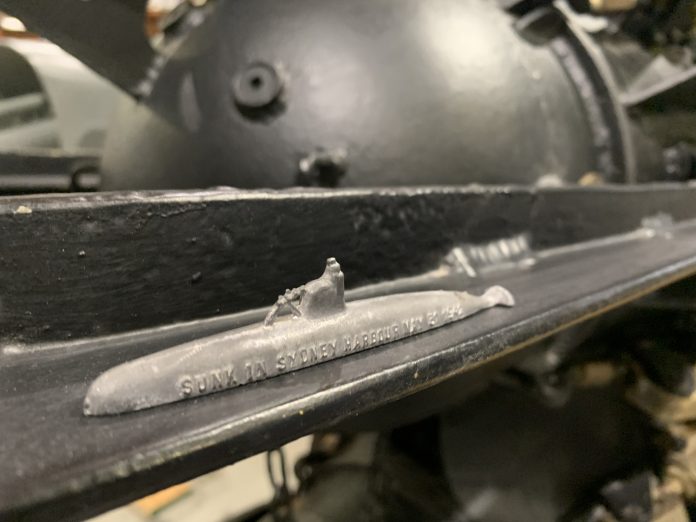
By Tom Lewis*
In 1942 Sydney Harbour was attacked by three Japanese midget submarines, launched from four mother submarines, one of which had flown an aircraft over the target area. In a night of mayhem, 27 people died, and the war had suddenly come to the southern states of Australia. One of the more unusual results from the attack was the generation of thousands of model 10cm lead submarine souvenirs, made from the boats’ ballast. Other pieces were simply nuts and bolts, while sometimes machine parts in total were sold. All of these are still in circulation in Australia.[1]
One submarine blew itself up when it was caught in the harbour’s defensive boom net, with both of the crew dying. The other two made it inside the harbour, and one attacked the cruiser USS Chicago. Both of its torpedoes missed, but a detonation under the accommodation vessel HMAS Kuttabul killed 21 sailors. This midget then escaped, the wreck being found north of the Harbour in 2006. The third submarine, hunted by small attack craft of the Royal Australian Navy, was cornered in Taylors Bay, and its crew shot themselves.
In 1943 a composite midget submarine made from parts of the two submarines recovered from Sydney Harbour were taken on a 4,000 kilometre tour to raise money for the war effort, under the command of Lieutenant-Commander John Sydney Bovrill, of the Royal Australian Navy.
The tour visited Wagga, Benalla, Ballarat, across to Adelaide and along the Victorian coast to Melbourne then back to Sydney. Souvenirs – envelopes of glass wool, and the tiny lead submarines – and postcards of the submarines were sold along the way. “Periscope certificates” were issued to those who had taken a look through the periscope to appreciate a submariner’s view of the world. The tour was a huge success, the exhibits drawing vast crowds. In Wagga for example, a city with a wartime population of between 11-12,000, over 6,000 visited the submarine.
At the close of the tour, the remainder of the souvenirs were passed on consignment in late April 1943 to the Australian War Memorial, which received “40,989 glass wool envelopes, 99,010 postcards (sold in sets of 9) and 6,780 individual miniature lead sub models.” The glass wool had been used as insulation in the submarines. It appears, as will be explained below, that even nuts and bolts from the submarines’ machinery were sold as souvenirs. In addition, pieces were taken off surreptitiously, both in the process of combing two submarines’ wreckage to make one, and on the tour itself – there were no fences, for example, to stop members of the public touching the vessel. Some of these stolen items are listed below, for many were returned to the authorities.
The display submarine was transported in three sections on Army transports, with all Navy personnel who travelled with the displays having seen “active service overseas”. Some of the attendance figures were most impressive: in Sydney for 8.5 weeks the display attracted 230,063 spectators; in Melbourne for eight weeks “more than 140,000 people”, with the highest number on one day being 14,466, surpassing Sydney’s highest of 14,325.[2]
More of the lead submarine models than were needed were made. The tour was originally proposed to include Queensland and northern NSW but that did not eventuate.[3] Of these interesting and unique tiny mementoes, “313 dozen” were sent to the USA, along with 25,000 postcards to assist in the “third War Loan drive”.[4] In a letter of 5 August 1943, Admiral Muirhead-Gould – who had badly botched the harbour defence but who escaped criticism – noted “313 dozen lead subs and 25,000 postcards disposed of through Department of Information to USA for sale.” Proceeds of the Australian sale of the souvenirs went to the RAN Relief Fund and King George’s Fund for Sailors.[5]
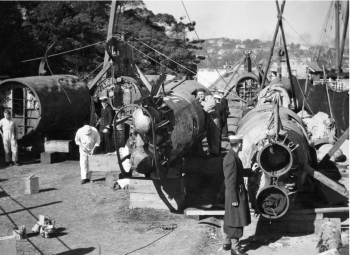
From at least one photo, it would seem the other main piece of one of the two wrecks, the conning tower, accompanied the exhibition, as did the sword of one of the commanding officers, Lieutenant Chuma – or was it Matsuo’s – see the same author’s previous article in ACANT.[6] While the sword seems to have gone eventually to the AWM, the conning tower of the Taylors Bay midget was then sent south to Melbourne. Presumably when the tour finished, it either went by road from Canberra, or more likely, split off from the main tour at the closest point to Melbourne. Whatever the case, it arrived at the sailor training establishment, some 90 kilometres south of Melbourne city, where Flinders Naval depot aka HMAS Cerberus was, and is still so today.
The conning tower’s role there is unclear. Presumably it served as an icon – reminding trainees that here is a very real outcome of your role: to fight and win at sea. It may have had a secondary role of at least providing a training aid: here is what a real submarine, albeit a small one, looks like. Here is a real periscope; here is a real pair of torpedo tubes, and so on.
Somebody later, either in the training establishment of HMAS Cerberus, or more likely in the Naval Headquarters – based in WWII in Melbourne, and later moved to Canberra – decided the relic should be returned to Sydney. Once again the conning tower was loaded on a truck, and once again it made a long road journey. On 23 November 1977 it arrived back in the city where it had once emerged, monster-like, from the deep.[7] Once there, it was photographed in place by the local newspapers, with sailors on top and in front of it. The newspaper article doesn’t say where it was placed, but that it was to be “a memorial”. The author remembers seeing it inside Garden Island in the 1990s, so it may have been there since its arrival. The conning tower is now in the Naval Heritage Centre at the end of Garden Island, where visitors can view it after taking a ferry ride to the centre.
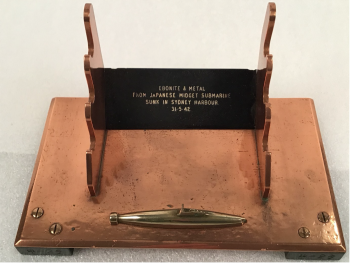
A rather different account of the “voyage” of the midget submarine was published around the time. The federal government, conscious of the need to heighten morale amongst the general population, had the three armed forces, through the Australian War Memorial, publish a series of books, given out free to the general public. Sometimes known as the As You Were set, they were given patriotic titles: for example the RAAF’s first volume was These Eagles and the Army’s Soldiering On. The Navy’s were all called HMAS, and numbered with Roman numerals. (No-one knew at the time of publication how long the war was going to go on – the Navy’s reach IV, while the Army’s used different titles.)
Most of the articles were sourced from serving members, and for security reasons they used their initials only. So the midget submarine article was written by “Lieut-Commander J.S.B.” The tone of the article reflects both the language of the times, and an upbeat, almost humorous style:
It is not so simple to send a shattered submarine, cruising about a continent. To begin with, where is your motive power? The R.A.N.V.R. has completely ruined everything original of this description which had ever been built into the Japanese submarines.[8]
At the best of times a submarine is a “poor fish” out of water. As briefly as possible then, the Navy found itself somewhat out of its depth. The problem developed amphibious proportions which necessitated an appeal to the Army. The latter, as ever, answered the call. Even so, it was not as simple as it sounds. First of all, it was necessary to produce a submarine on wheels – in itself a feat of naval architecture, which, by the way, promoted an oft-repeated question, “did it have wheels on it when you got it?”
…this difficulty having been overcome, the Army undertook to tow us, if needs be to Timbuctoo and back….at long last, we slipped our moorings.
According to some of the paperwork sighted in relation to the trip, bridges were a major problem for the submarine, even though it was often taken apart into its three major sections: bow, conning tower/midsection, and stern. HMAS II makes light of one such trial:
Berrima, Goulburn, Canberra, Gundagai, Wagga, Holbrook, Albury, Melbourne…Where, I wonder, should I begin. Perhaps at none of these. Let me therefore start upon a very rocky bridge at a spot called South Tracutta, between Gundagai and Wagga.
These country bridges were never designed to carry submarines – but, all for all that, we had to get to Wagga. The Army Transport Officer and I went ahead. The A.T.O. was a big man, and when he disembarked from the utility car in which we were travelling, the bridge shook under his weight. My heart sank. As aforesaid, he was a big man who must turn the scale at many stone. But we were thinking in terms of tons! So just what would happen to the submarine when she attempted to cross this “River Styx”. She crossed! So we called a halt, and boiled a billy of tea. I think we were entitled.
The popularity of the submarine tour concept was huge. Big crowds attended the displays, and spectators were even allowed to graffiti the outside of the casings, as the occasional photo of the times attests. Bear in mind too that the people of inland Australia especially were very isolated. Radio was limited; television had not yet reached any of the country and would not do so for another 20 years, and newspapers were the major source of news. Different entertainment of any sort was much valued.
The population of Wagga is reported by the guide book to be betwixt and between eleven and twelve thousand. Be that as it may, upwards of six thousand pegged the turnstile. Once again this was so largely thanks to the Army, who were kind enough to provide a full military band.
Entry of the submarine to a population centre, if it could be arranged, was usually at a prearranged time, which was advertised by poster and word of mouth to the local people. They turned out with great expectation. Usually, the need for a parade was eagerly seized upon:
The town band, the N.A.P., the girls’ auxiliary N.A.P. in their white skirts and scarlet uppers, the boy scouts, the girl guides, the V.D.C. in uniform with rifles, the A.R.P. rescue squads and demolition parties, the entire local fire brigade and fire engine, followed by our sections of submarine. In all, the procession must have exceeded half a mile in length. One might wellnigh say that whilst half the population took part in the procession, the other half was looking on! [9]
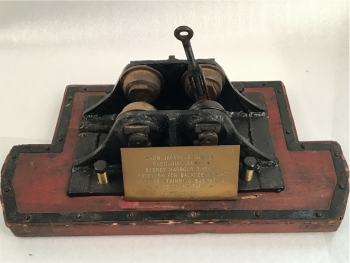
The process was not however without the occasional potential disaster, bridges aside:
Adelaide of course is a capital city, where traffic is a consideration which must not be forgotten. We were due to pass the Town Hall clock at 4 p.m. on the 12th March. A mechanical breakdown, way up in the Mount Lofty ranges, was a trifle disconcerting to say the least of it.
The speed of the fleet is the speed of the slowest ship – and the slowest ship, through no fault of her own – was not too popular. However, by dint of combined effort and abuse, she rejoined the convoy, and we sailed down King Williams Street, Adelaide, in a single line ahead. We passed the Town Hall clock on the very stroke of eight bells.
Finally:
…and so to Canberra, where in accordance with previous arrangements we were in position at the War Memorial at 1600 on the 28th April, 1943.
Thus ended a curious cruise. Though never commissioned as a unit of H.M. or H.M.A. Fleet, we flew the White Ensign from start to finish – and furthermore, we steamed into Canberra flying a paying-off pendant. Many must have wondered what it was all about…
Moneys raised were disbursed to a number of organisations assisting widows and children, or in general naval or merchant navy personnel. For example, the Australian Navy Relief Fund received 4,750 pounds, while the Sydney Hostel for Naval Personnel 7,500.[10]
Submarine items dispersed
Where are all of the objects taken from the submarines? It would appear they are scattered across Australia, and even overseas. As a “coffee table” book composed by the Australian War Memorial remarks, it appears items taken from the wrecks were thought by many owners to be better off safeguarded for the nation, for donations began to appear, ‘as if attracted by a magnet.” [11]
Some of the more significant items are cited below, although this is an informal listing, as within the lifetimes of such collections there are often large donations which go uncatalogued for want of resource time.
Within the Australian War Memorial
A 1,000 stitch senninbarri cloth belt
Originally donated to the AWM, this ceremonial clothing item taken from Matsuo’s body was returned to the Japanese family of the commander of the Taylors Bay submarine. Lieutenant Matsuo’s mother visited Australia in 1968. She was received with honour everywhere she went. Her visit included the Australian War Memorial, where she inspected the composite submarine. She made donations of a poem she had written about her son, printed onto a cloth, and an album of paintings and other poems. The AWM Director of the time, Bill Lancaster, gave back to her the 1,000 stitch senninbarri cloth belt, which had been in the Memorial since 1942.[12]
The submariners’ pistols
A small firearm was usually taken to sea in each midget submarine. Sometimes these two weapons are described as “revolvers” – they were indeed rather semi-automatic pistols.[13] Jenkins suggests Matsuo was found with a “8mm Taisho service pistol.”[14]However professional advice taken on the pistols from Curator Jared Archibald OAM of the Northern Territory Museum and Art Gallery shows otherwise.[15] Comparing the photograph taken at the time of the warrant officer and the lieutenant commander, the handgun in the photo can be identified as a Nambu 7.9mm Type 14 semi-automatic pistol. Curator Archibald advises further:
The weapon has the extended trigger guard that was introduced in September 1939. It also has the magazine retention spring on the front of the grip frame that was introduced in December 1939. It also has the correct lanyard (a yellow cord with a visible leather collar) hanging down from the lanyard staple at the rear of the frame. The magazine is partially extended and the officer has the end of it cradled in his hand.
Comparing this image to the Nambu Type 14 [omitted[16]] shows this second item also has the extended trigger guard, the magazine retention spring, and the correct lanyard – but is missing its cocking knob, and has the 17 groove grips. The grips would mean that it is one of the “Nagoya Nambus” made in their Kokubunji factory. (Sidearms were not issued to Japanese officers, but had to be privately purchased, which means quite a variety can be found in WWII history within Imperial forces.)
The AWM has at least one pistol from the midget submarines – there is only one listed as such in their collection. However 15 Nambu Type 14 pistols are within their collection, with several having an “Unknown” history. It is also probable that the same logic applies to a pistol from the Chuma boat, and only one has been recovered. Then again Lew Lind, a naval officer who was in Sydney at the time, and who later wrote a book on the attack, cites two.[17]
A Himitsu-Bako puzzle box. This was found in one of the submarines by a Robert Judge, a civilian boilermaker. He took it for a souvenir, but it was later donated to the AWM in 2007. [18]
A Seiko Japanese naval clock, complete with a winding key, was obtained by the AWM from a scrap-metal merchant’s family in 1970.[19]
A stop watch, obtained by a rigger who had worked at Garden Island.[20]
A Japanese “battle ensign” – a red and white flag with the red sun and rays on a white background.[21]
Lieutenant Chuma’s leather helmet, retrieved by one of the workers at Garden Island.[22]
A sake cup was found in the composite model in the 1960s, when it was displayed outdoors. The AWM notes that such cups were sometimes filled with sake and placed in the model by Japanese visitors, presumably in commemoration of the loss of the submariners. [23]
A lemonade bottle, with signage advising it came from the Matsuo submarine.
A glove within the AWM display cases. However, there is no advice on the signage advising its provenance.
A nut (from a nut and bolt) with an attached label as being a “Guaranteed Souvenir” from the tour, advising of its source as being from one of the raid midget submarines, and signed by “Muirhead-Gould, Rear-Admiral-in-Charge, Sydney”.
A lead souvenir submarine. The AWM displays one of these, made from the lead ballast from the two recovered midgets. The other have ended up in thousands of households. They appear occasionally in antique or collectibles shops, often selling for around $100.
Within the Australian National Maritime Museum
The Australian National Maritime Museum in Sydney’s Darling Harbour hold two items of significance. The first is a Japanese midget submarine revolution counter, made by the Kuramoto Instrument Manufacturing Co. Ltd, Tokyo. The second is a Japanese midget submarine amperage meter, made by Tokyo’s Denki Seizo Kabushiki Kaisha.
The ANMM also has a number of associated items, for example a souvenir card from the tour stating that: “This is to certify that the bearer of this card operated the controls of the periscope in the Japanese midget submarine sunk in Sydney Harbour on 31 May 1942”. The Museum also holds a scrapbook from an “Emily G Sutherland” of news clippings regarding the submarine attack, one of which is the Pix magazine front cover featuring Rear Admiral Muirhead-Gould.
In the Garden Island Naval Heritage Centre
The Heritage centre’s most imposing exhibit is the conning tower left over from the midget composition. It may be inspected at very close range by visitors. One of the most interesting aspects, and which attracts seemingly the most comments, is the very small size of the doors inside the submarine. Most Australian male adults would have trouble fitting through them.
The Heritage Centre also has two engine room pipes, and a bridge voice pipe in its collection, as well as the remains of the Kuttabultorpedo – what was left after the forward part exploded.
In the Navy’s Spectacle Island Collection
This collection of naval artefacts, usually off-limits although often open to guided tours, has the stern section of one of the boats – which one is explained below – with propellers, left over from the midget composition.
The Collection also has souvenirs from the tour, including a bolt (as in a nut and bolt) with a label signed by Muirhead-Gould. Other items include a “trench art” ashtray, featuring a metal model submarine addition. (“Trench art” is the generic name given to artistic items made from items found on battlefields, or taken from military stores. For example, pen and pencil holders made from brass shells, usually trimmed to make a cylinder without the taper.)
A very interesting item is a variation of the lead model submarine, rather like those souvenirs sold on the tour, but made from “ebonite and metal”. “Ebonite” is a vulcanised material made from hard rubber – many bowling balls are said to be made from it. This shows that more than the lead from the submarines’ ballast was used for souvenirs. We have no way of knowing whether more ashtrays and second-variant model submarines were made.
A lever, said to be part of the trim mechanism from either of the submarines, finishes off the Spectacle Island Collection.
Elsewhere
The Morse Code key from Ha-21. A photo of this item, with this wording, may be seen online at the reference.[24]
Steven Carruthers, author of Japanese submarine raiders 1942 A maritime mystery, (Casper Publications, 2006) took a photo of a morse key which is from Ha-21. Steven was giving a talk in 2007 on the midget submarine attack and was approached by a woman in the audience who had found the key amongst a box of items left after the death of her father, Lt Percy Wilson. He was the duty Intelligence officer on Garden Island, who had investigated the midget submarines.
Many items have disappeared. For example, the Leica camera mentioned by Lew Lind, an expensive and prized item to have in the 1940s, may have found a new home with a dockyard worker, or a naval man, or anyone, really, who came into contact with the midget submarines. Souvenirs were sold, as evidenced by the nut now on display in the War Memorial. Others, sadly, have been taken from the midget submarine sunk off the northern beaches of Sydney.
Conclusion
Australia was attacked by three midget submarines in mid-1942. Two were recovered, and the third later found outside Sydney Harbour – it is still in its original condition, albeit open to the sea. Thousands of souvenirs were made from the recovered boats – some intentionally, and others purloined – and these still remain in homes and museums today.
Much of the submarine contents are now scattered across Australia, in a distribution never imagined by the Japanese designers, builders, and operators of the submarines. But in a very special way, the fate of the two submarine wrecks recovered from Sydney Harbour in 1942 have provided a secondary, and very interesting story.
-o-o-O-o-o-
*Dr Tom Lewis OAM is a military historian. This article is drawn from Attack on Sydney Harbour (2022), which describes the attack in detail, also highlighting the high-level command failures, and the unrecognised bravery and skill of the small ship crews who chased two of the submarines to their end. His latest book is The Sinking of HMAS Sydney – “living, fighting and dying on WWII cruisers” – both titles from Big Sky Publishing.
[1] A note on sources. This article is drawn from the book Attack on Sydney Harbour, (Big Sky, 2022) by the same author. It contains several hundred references from which information can be drawn on the overall attack.
[2] NAA. “Midget Submarine exhibition”. Item ID 6005162.
[3] RAN Minute 17 Apr 1943. NAA 6005162 (p. 163)
[4] Director of the AWM to Rear Admiral in Charge, Naval Headquarters, 31 Aug 1943. NAA 6005162 (p. 96, and letter to Muirhead Gould from an unnamed US official (p. 104)
[5] Australian War Memorial. “Souvenir: Small lead model Japanese midget”. submarinehttps://www.awm.gov.au/collection/C326487
[6] NAA. “Midget Submarine Attack on Sydney Harbour – Signals” Item ID 399556 (p. 98)
[7] The Canberra Times. “Mini-submarine section returned to Sydney”. 24 Nov 1977. (p. 16) The article says the conning tower was there from 1943.
[8] Royal Australian Navy. Australian War Memorial. HMAS II. “A Maiden Voyage in Uncharted Waters”. 1943. (pp: 89-96) The author was a Lieutenant Commander JS Bovill – see NAA. “Midget Submarine exhibition”. Item ID 6005162, p. 6.
[9] It is presumed the NAP is the Naval Auxiliary Patrol, although it is not known whether that organisation had a “girls’ auxiliary”. The VDC is the Volunteer Defence Corps, a “Home Guard” organisation; the ARP the Air Raid Patrol.
[10] Minister for the Navy Norman Makin, undated telegram to the Hon J Beasley. NAA 6005162. (p. 116)
[11] Australian War Memorial. Treasures from a Century of Collecting. Murdoch, 2021. (p. 406)
[12] Australian War Memorial. Treasures from a Century of Collecting. Murdoch, 2021. (p. 406)
[13] See for example Bob Wurth’s 1942: Australia’s Greatest Peril. (p. 239)
[14] Jenkins, David. Battle Surface. Random House, 1992. (pp: 220).
[15] Personal communications, Feb-March 2022.
[16] Omitted wording is “that is displayed at the AWM”. A photograph taken by Dr Brad Duncan when the midget composite submarine was in the public section of the AWM shows what looks to be the pistol without the cocking knob. It is presumed the two are the same. The pistol was removed along with the midget submarine when the King-Hall renovations began circa 2020.
[17] Lind, Lew. The midget submarine attack on Sydney. NSW: Bellrope Press, 1990.
[18] Australian War Memorial. Treasures from a Century of Collecting. Murdoch, 2021. (pp: 406-407)
[19] Australian War Memorial. Treasures from a Century of Collecting. Murdoch, 2021. (pp: 406-407)
[20] Australian War Memorial. Treasures from a Century of Collecting. Murdoch, 2021. (pp: 406-407)
[21] Australian War Memorial. Treasures from a Century of Collecting. Murdoch, 2021. (p. 404)
[22] Australian War Memorial. Treasures from a Century of Collecting. Murdoch, 2021. (pp: 406-407) Displayed with signage saying the name was Chuman.
[23] Australian War Memorial. Treasures from a Century of Collecting. Murdoch, 2021. (p. 406)
[24] Heritage NSW. https://www.heritage.nsw.gov.au/about-our-heritage/feature-wreck-m24-midget-submarine/the-raid-sydney-31-may-1942/salvage/



